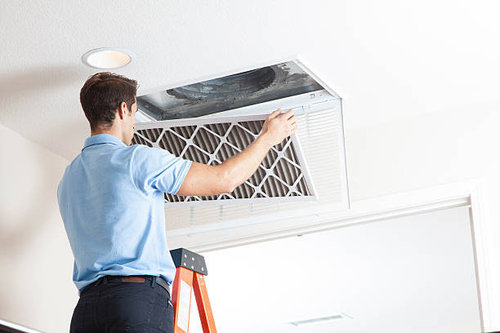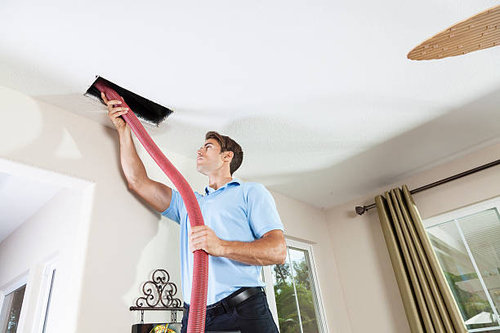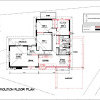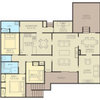Cleaning and sanitizing techniques air conditioning ducts
Reclaiming the air conditioning ducts is an operation that must do periodically using specific products for sanitizing the air ducts. Cleaning and sanitizing air ducts are very important to guarantee not only the performance of the systems but also maintaining the air quality for the health of the people who occupy the building.

Using specific disinfectant products and substances for these operations ensures both correct cleaning and the elimination of microbiological contaminants, which, if inhaled can be harmful to health.
In this article, we will see which are the most effective products and techniques to treat air ducts and other components, but also why regular cleaning and disinfection of the ducts are essential.
Why is it necessary to clean and sanitize the air channels?
Inside the air ducts, on the external air handling unit, and on the points of discontinuity of the systems (such as heat exchange coils, shutters, fins, or filters), dirt, dust, particulates and pathogenic microorganisms accumulate over time (bacteria, molds, spores, fungi, viruses).
These components, besides hindering the correct and regular exchange of air, can make up a serious source of chemical and microbiological contamination of the air.
And it is precisely the unhealthy indoor air that is the primary cause of the Sick Building Syndrome, a pathology that involves the occupants of buildings and indoor environments equipped with degraded and inefficient mechanical ventilation or air conditioning systems.
Proper ordinary and extraordinary maintenance of the Air conditioning systems is essential for:
- Increase the efficiency of the plant itself, reducing energy costs;
- Make indoor air better and breathable;
- Eliminate any allergens from dust and pollen;
- Break down the concentration of bacteria, viruses, molds, and fungi that may be present;
Check for Legionella bacterium and then proceed with its elimination.
Before delving into this article, however, it is necessary to make a due premise, clarifying the meaning of the terms at stake.
Cleaning, Disinfection, Sanitation: let's clarify the terms
Cleaning, misusing their synonyms. When we talk about such an important topic as the maintenance of the air ducts, however, it is advisable to clarify:
- Cleaning is a set of manual and/or mechanical operations aimed at removing visible dirt from an environment or a surface;
- Sanitization is an intervention aimed at eradicating bacteria and contaminants that normal cleaning activities cannot remove;
- Disinfection comprises the use of chemical or physical disinfectant agents (for example heat) capable of destroying or inactivating the pathogenic microorganisms present on the surfaces to be treated.
Cleaning is a preliminary operation that is essential for the subsequent phases of sanitization and disinfection. Therefore, there can be no sanitization and disinfection if the dirt is not first removed with water and/or specific detergents.
The removal of dirt is essential for the success of the subsequent disinfection and sanitizing phases, which are carried out using particular detergent chemicals that bring the microbial load back into the ducts under acceptable hygiene standards.
In the Air conditioning field, I used the term reclamation, which comprises a joint cleaning, sanitizing, and disinfection operation to eliminate all traces of material previously contained or treated within a plant. This operation is essential to avoid, for example, cross-contamination, i.e. cross-contamination.
Sanitation of air conditioning channels: types of cleaning systems
By remediation of Air conditioning systems, therefore, we mean complexity of actions that can be two main categories: cleaning, the mechanical removal of dust and dirt inside the channels and from the AU - and disinfection - which disinfects the implant surfaces with chemicals - the last step of the whole process.
As regards the actual cleaning, the Air conditioning ducts are usually cleaned by any mechanical means that allow the removal of dust and dirt.
There are several cleaning systems for Air conditioning ducts, however, the most used are:
- Blowing;
- Brushing;
- Compressed Air.
We then integrated all three systems with the use of a vacuum cleaner, necessary to convey the removed dirt outside.

The choice of the most suitable technique will obviously depend on the structure of the Air conditioning system and on the technical information collected through the preliminary video inspection of the air ducts. Among all these cleaning methods, however, the procedure undoubtedly most used, because it is more effective, is that of brushing.
Let's see what it is.
Cleaning the air ducts by brushing: how does it happen?
Brushing basically comprises the use of a rotating brush that is introduced inside the air duct. Once we activate the external electric motor. , the brush will raise dust and dirt, which then with a vacuum cleaner, we can clean.
The brushing of the air ducts is, therefore, the most complex of the remediation operations of Air conditioning systems. But how does this procedure happen?
The canal is divided into sections ranging from 50 meters to 100 meters;
The air vents are suitably sealed and insulated to prevent contaminants from escaping and dispersing into the internal environment;
A maximum depression is created in the center of the segment to be reclaimed, and close to zero on its walls, by applying an aspirator;
The mechanical brushes, rotating clockwise and anticlockwise, remove the solid residues and, at the same time as the suction, raise them up to the maximum suction point;
The deposits of dust and dirt are captured and conveyed inside the fan of the aspirator equipped with absolute filters.
In the next paragraphs, we will focus, in particular, on the equipment and products necessary for the cleaning and subsequent sanitization of the air ducts.
What equipment do I need for proper cleaning of the air ducts?
Thorough cleaning and sanitizing of the ventilation ducts obviously requires the use of suitable equipment and tools by specialized technicians to carry out the procedure correctly.
We can use a wide range of electric or manual tools for normal drainage and sanitizing of ducts, such as:
Access tools to create points of entry into the HVAC system and facilitate inspection and cleaning (hacksaws, tinsmith shears, etc…); by a skilled and professional air condition Maintenance team.
Visual inspection tools, necessary to assess the state of the channels and the possible presence of dirt and contaminants, but also to monitor the cleaning process (hand mirror, direct vision periscope, optical borescope, a robot with camera, etc ... );
Manual or electric cleaning tools (brushes, pneumatic and electric rotating brushes, pneumatic tools such as air whips, blowguns or air hoses, etc…);
Suction collection devices, necessary to create a vacuum in the HVAC system to control the rate of diffusion of contaminants and to capture them during the process conducted byprofessional air condition maintenance (suction motors with HEPA filter);
Sources of Compressed Air;
Hepa manual aspirators and liquid aspirators (designed to extract liquid contaminants from the drain pan, the evaporator coil, and other areas);
Sanitizing equipment (Atomizer and Nebulizer).
Besides the channels, the cleaning and sanitizing treatment also concern the vents, the diffusion grids (hemostats), and the Air Treatment Unit (AHU) which, unlike the channels, is treated with a chemical washing using: water high pressure (pressure washer) and chemical products to decrease, descale and disinfect every part.
Air duct cleaning tools and machines: what do you need for brushing?
Specifically for the air duct brushing procedure, the tools and machines that can be part of the kit are:
- Tapes or plates for insulating the vents;
- Suction fan with filter, to capture and evacuate dirt and dust raised by the brushes;
- Mechanical means, which can be a multifunctional robot equipped with a brush or a flexible whip with a brush);
- Plates or balloons inflated with compressed air, which is used to dissect and isolate sections of the duct during cleaning operations;
Cameras mounted on the robot or on the brush, to monitor cleaning operations in real-time.
This instrumentation can be used in those channels without internal insulation. Where the channel is internally insulated by mineral wools such as glass or rock, in fact, the jet of compressed air is usually used instead of the brush since the rotating movement of this machinery could flake the insulation present (in rare cases the brushing technique is used by using soft bristles).
What products are used to sanitize the air ducts
The disinfectant and sanitizing products that are used in the phase following the cleaning phase can be classified into physical disinfectants (heat, UV radiation) and organic chemical disinfectants (alcohol, aldehydes, surfactant compounds) or inorganic (heavy metal salts, acids, agents oxidants).
The inorganic ones, despite having a very high power of action, are not easy to handle and quite dangerous, therefore organic ones are more used which in any case have a high antimicrobial action.
The main chemicals used for plant disinfection are:
- Quaternary ammonium salts;
- Hydrogen peroxide;
- Peracetic acid.
The choice of a disinfectant product rather than another is made primarily based on the compatibility of the chemical product with the materials to be treated, but also on the type of environments served by the Air conditioning systems and the type of contamination that is detected in the monitoring phase.
Salts of quaternary ammonium
They are surfactant compounds that have a high disinfectant action in particular on:
- Gram + bacteria;
- Gram- bacteria (with varying efficacy).
These chemical compounds work by dissociating bacterial membrane proteins and degrading those of nucleic acids. We usually use them in a concentration of 1-2% diluted in water, for the broad spectrum disinfection of almost all Air conditioning systems.
Hydrogen peroxide
The disinfectant power of hydrogen peroxide depends on the production of free hydroxyl radical in the case of the catalytic action of iron (Fe2 +) and Copper (Cu2 +), supplied by the same bacteria.
This action releases a high concentration of oxygen, which determines the alteration of the cellular composition of the pathogenic microorganisms and the consequent disinfection.
Hydrogen peroxide is mainly used for the disinfection of:
- Hospitals;
- Pharmaceutical premises;
- Sterile environments.
All particularly sensitive places where the admission of uncontaminated air must be guaranteed. For the disinfection of the Air conditioning systems used in these environments, it is used in concentrations between 5 and 25%, so as to guarantee an effective sporicidal and bactericidal action.
Peracetic acid
- It is an organic acid characterized by:
- A pungent vinegar smell:
- High power of irreversible oxidative action
- A high bactericidal action if used in concentrations between 1 and 2.5%.
This type of chemical compound is used above all for the disinfection of Air conditioning systems that serve food environments.
All these disinfectants are injected into the Air conditioning systems using an electric nebulizer, through the AHUs, or from the delivery and return vents until the ducts are completely saturated so as to guarantee complete disinfection of the system.
Ozone is also often used for sanitation. However, in the case of air ducts, their use is not recommended, both because it is highly reactive and unstable and because it must be produced at the very moment in which the sanitization takes place. This implies a certain complexity in the management of the procedure.
Furthermore, if not used in the right concentrations it can also cause health problems for the users of the environment served by the Air conditioning systems being treated.
⬇ If you need assistance for the remediation of Air conditioning systems or analysis of the air quality in your company, call us now at the toll-free number ⬇





Related Discussions
Pre purchase ducted air conditioning check
Q
POLL: How do you keep your home cool in summer?
Q
7 Essential Methods to Restore Floodwater Damage
Q
Understanding Fire Damage Cleanup: Essential Steps and Procedures
Q